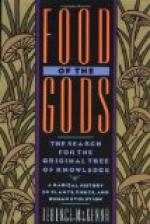In Nicaragua this practice was so general that “none but the rich and noble could afford to drink it, as it was literally drinking money.” A rabbit sold there for ten beans, “a tolerably good slave” for a hundred. Slaves must, however, have been at a discount just then, if the silver value of the beans was no greater than when Thomas Candish wrote in 1586: “These cacaos serve amongst them both for meat and money ... 150 of them being as good as a Real of Plate”—about 6d. “A bag,” of unknown size, “was worth ten crowns.” One of the storehouses of Montezuma, the last of the old independent Mexican Chieftains,[18] was found by the Spaniards to contain as much as 40,000 loads of this precious commodity, in wicker baskets which six men could not grasp.
John Ogilby, writing in 1671 of the produce of America, says:
“But much more beneficial is the cacao, with which Fruit New Spain drives a great Trade; nay, serves for Coin’d Money. When they deliver a Parcel of Cacao, they tell them by five, thirty, and a hundred. Their Charity to the Poor never exceeds above one Cacao-nut. The chief Reason for which this Fruit is so highly esteem’d, is for the Chocolate, which is made of the same, without which the Inhabitants (being so us’d to it) are not able to live. Before the Spaniards made themselves Masters of Mexico, no other Drink was esteem’d but that of the Cacao; none caring for Wine, notwithstanding the Soil produces Vines everywhere in great Abundance of itself.”
From contemporary travellers’ records are to be gleaned many such strange facts and stranger fancies regarding the precious bean and its products, some of them extremely quaint and curious. Bancroft, for instance, writing of the Maya races of the Pacific, tells us that “before planting the seed they held a festival in honour of their gods, Ekchuah, Chac, and Hobnil, who were their patron deities. To solemnize it, they all went to the plantation of one of their number, where they sacrificed a dog having a spot on its skin the colour of cacao. They burned incense to their idols, after which they gave to each of the officials a branch of the cacao plant.” Palacio also tells us that “the Pipiles, before beginning to plant, gathered all seeds in small bowls, after performing certain rites with them before the idol, among which was the drawing of blood from different parts of the body with which to anoint the idol;” and, as Ximinez states, “the blood of slain fowls was sprinkled over the land to be sown.”
[Illustration—Drawing: [From Bontekoe.] A CACAO PLANTATION. (One of the earliest illustrations of this subject known, showing the shade trees, and beans drying.)]
The idea that secret rites were necessary at the planting of cacao to counteract their ignorance of its requirements was long current also among the superstitious Spaniards, who similarly accounted for the early failures of the English, as witness the following amusing extract from a contribution to the Harleian Miscellany in 1690:




